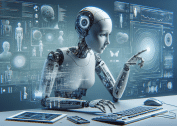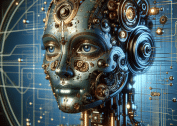Artificial intelligence is transforming daily life and work in ways many never anticipated. This article guides readers through the world of AI tools, spotlighting trends, practical insights, new breakthroughs, and what’s making people curious. Uncover how AI impacts you and discover which innovations are shaping futures.
AI Tools Shaping Everyday Life
Artificial intelligence tools now touch nearly every part of life. From smart assistants in your phone to recommendation algorithms on streaming platforms, AI has become a silent force in daily routines. These tools learn from data, adapt, and often make experiences more convenient. Voice assistants organize schedules, while music services suggest songs based on preferences. Behind the scenes, algorithms filter spam, translate languages, and help spot security threats. It’s no longer about distant gadgets—AI easily fits right into ordinary moments, making tasks significantly easier. The growing influence of AI means its applications are expanding in both surprising and subtle ways.
Recent interest in generative AI, such as chatbots and image creators, has exploded. People often experiment with large language models to brainstorm ideas, generate content, or solve problems in seconds. These systems use deep learning and huge volumes of information to mimic human responses. Some AI writing tools help craft blog posts, summarize meeting notes, or even create poetry. Others can analyze images or audio, converting complex media into useful insights. Each time AI adapts, it gets a little bit better, improving how people interact with technology through natural language and easy interfaces. Curiosity keeps driving new experiments, as users explore what these tools can really do.
AI’s reach also includes less visible sectors like healthcare, home energy management, and smart appliances. Medical diagnostics increasingly rely on sophisticated AI models to spot unusual patterns in scans or recommend treatment pathways. In energy, learning thermostats adjust settings for efficiency and comfort, helping reduce costs and resource use. Smart refrigerators track expiration dates and create grocery lists. These inventions build on the same fundamentals: learning, adaptation, and prediction. As more industries embrace AI, the lines between ordinary technology and smart systems continue to blur, creating a world where intelligent tools quietly operate in the background.
Understanding Machine Learning and Its Magic
Machine learning powers most modern AI applications that people interact with. The core principle: computers learn from data rather than being programmed with rigid rules. With enough examples, a machine learning system starts to spot trends and make predictions. For example, email platforms use machine learning to recognize spam patterns, routing unwanted messages away from inboxes. Photo apps identify faces, pets, or even landmarks with surprising accuracy. In finance, algorithms review market data to help detect fraud or forecast trends. Unlike traditional software, these systems adapt as new information arrives, becoming more intelligent over time.
Supervised, unsupervised, and reinforcement learning are terms you might hear. Each type addresses different problems. Supervised learning often tackles tasks with clear examples and outcomes—like classifying images or recognizing spoken words. Unsupervised learning helps find hidden structures in messy data, clustering users with similar behaviors. Reinforcement learning, meanwhile, teaches agents through trial and error, rewarding good decisions as it learns. This variety explains why AI can excel at translating text, mastering complex games, or optimizing delivery routes. The underlying technology is always evolving, fueled by advancements in data collection and computational power.
Breakthroughs in deep learning and neural networks are especially noteworthy. These systems mimic how the human brain works—processing data through layers of artificial neurons. It’s what enables modern voice assistants to understand speech, helps cars navigate cities autonomously, and powers those impressive deepfake videos. With open-source projects and cloud-based tools, experimenting with machine learning is now within reach for many. This accessibility is turning passive users into active creators, sparking innovation and making AI a bigger part of collective conversations.
Real-World Uses of AI That Might Surprise You
Many are surprised at just how many ways AI is woven into the modern world. In healthcare, algorithms assist with diagnosing diseases from medical images, sometimes spotting issues doctors might miss. Researchers use AI to analyze genetic data and predict disease risks, opening the door for earlier interventions (Source: https://www.nih.gov/). In agriculture, drones guided by AI monitor crops and identify areas in need of water or nutrients, improving yields and saving resources. Retailers leverage smart inventory systems to predict demand and manage stock, reducing waste and improving customer satisfaction. These applications might feel futuristic, but many of them are already common across diverse industries.
Traffic management is undergoing a transformation thanks to artificial intelligence. Smart cameras and software analyze real-time road conditions, predicting congestion and suggesting alternate routes to drivers. Major cities are rolling out adaptive traffic lights that change timing based on immediate fluctuations in flow, easing bottlenecks. In logistics, package delivery giants use AI for dynamic routing, reducing travel times and fuel consumption. The underlying technology digs deep into vast datasets, turning raw numbers into actionable insights—giving a taste of what a more connected, efficient infrastructure could look like.
Even in entertainment, AI’s flair is hard to miss. Streaming platforms recommend shows and movies based on your taste, learning preferences as you watch. Video game studios use AI to create adaptive non-player characters that respond to player actions, making gameplay more engaging. In sports, teams analyze player statistics and simulate match outcomes to inform strategy. AI even helps broadcasters generate automatic highlight reels by tracking the most exciting moments in real time. Sometimes, the best innovations work so seamlessly, you hardly notice how much they’re doing in the background.
Responsible AI: Ethics, Bias, and Transparency
As AI assumes more responsibilities, conversations about fairness, transparency, and ethics grow in importance. It’s not just about clever programming—real lives are affected when AI makes decisions in healthcare, justice, or hiring. For example, a hiring algorithm may unintentionally favor certain groups, reproducing societal biases found in its training data (Source: https://www.brookings.edu/). This highlights why transparency is vital: people need to know how conclusions are reached. Researchers and institutions are setting guidelines to hold AI systems to high standards, demanding that outcomes can be explained and audited. Increasingly, users want assurance that algorithms operate fairly and that data is protected.
Major industry leaders and academics are working together on ethical frameworks for artificial intelligence. Some propose robust regulatory systems designed to assess risks before deployment, while others focus on technical solutions for detecting and reducing bias in models. AI developers now share their methodologies openly, encouraging peer review and feedback. Practical resources help organizations conduct ongoing audits, document model decisions, and maintain accountability through clear reporting (Source: https://www.nist.gov/). Ongoing dialogue in this area helps prevent unintended harm and builds trust among users.
Transparency intersects with privacy concerns, especially as AI learns from personal data. Legislation such as the General Data Protection Regulation shapes how data is collected and used, emphasizing an individual’s right to know what information is being analyzed (Source: https://ec.europa.eu/info/law/law-topic/data-protection_en). Individuals, advocacy groups, and government agencies push for greater clarity on how AI intersects with human lives. This trend fosters new privacy-centric innovations—such as anonymized datasets and algorithmic explainability features—so stakeholders and everyday people can better trust the smart tools they rely on.
AI, Creativity, and Human Potential
Artificial intelligence is no longer reserved for analytical or repetitive tasks. It now plays a major role in unleashing new forms of creativity. AI models generate music, produce stunning artwork, write stories, and even compose poetry. Artists experiment with neural networks to create original pieces or remix classics. Musicians use AI to assist in composing tracks or mastering audio. These advances cannot replace the artist’s vision, but they do provide powerful new tools that augment creativity. Some AI-driven platforms analyze millions of artworks to help suggest styles, palettes, and motifs. Human and machine collaborate, pushing boundaries further than before.
Writers and filmmakers are exploring what generative AI can offer. Screenwriters draft scripts with AI support that suggests dialogue or fixes plot holes. Journalists rely on AI for summarizing interview notes and producing rapid, error-checked reports (Source: https://www.poynter.org/). Video editors use AI-driven software to automatically tag scenes, simplify organization, and even color-correct footage intuitively. Meanwhile, architects take advantage of AI modeling to design innovative structures, testing thousands of variations before finalizing blueprints. It’s clear that creative industries are being transformed by intelligent collaboration, opening new avenues for experimentation.
Education is another arena where AI’s creative potential shines. Innovative adaptive learning platforms adjust their teaching style in response to a learner’s progress, offering custom resources or quizzes. Teachers and students alike can rely on AI tutors for feedback or research tips, making studying feel more personal and engaging. This synergy is sparking new conversations around lifelong learning and flexible skill-building options. By playing a supportive role, AI is helping learners of all backgrounds achieve more—sometimes turning daunting tasks into manageable, rewarding projects.
Navigating the Future: Trends and Emerging AI Technologies
Staying ahead of emerging artificial intelligence trends can feel overwhelming, but it’s rewarding. Quantum computing and AI integration promise breakthroughs in tackling complex scientific problems. Edge AI allows intelligent processing to move closer to where data originates, reducing latency for smart cameras, industrial robots, and wearable devices. Tiny machine learning models are now running on small hardware, enabling smart sensors to make decisions independently, reducing cloud dependence. These advances make AI faster, safer, and more nimble. As connectivity grows, so does curiosity about what surprises tomorrow’s systems might deliver.
Another trend capturing attention is explainable AI (XAI). It emphasizes making AI’s decisions more understandable for developers and end-users. With XAI, users can see why a model chooses one option over another, fostering transparency and smoothing adoption across regulated industries. At the same time, responsible AI initiatives are focusing on sustainable computing, minimizing energy consumption during intensive training and operation. Businesses and researchers turn to ethical checklists and sustainability targets, aiming to reduce the carbon footprint of AI advances (Source: https://www.ibm.com/policy/ai-ethics/).
Partnerships are springing up across borders, with global enterprises and academic labs sharing breakthroughs and datasets. Open-source AI communities allow anyone to contribute or learn, which democratizes access to groundbreaking technology. These groups fuel rapid progress but also highlight the need for global ethical standards. The coming years are likely to see advances in robotics, natural language processing, and human-AI collaboration. The landscape keeps changing—and informed curiosity is the best way to navigate it all.
References
1. National Institutes of Health. (n.d.). Artificial Intelligence and Medicine. Retrieved from https://www.nih.gov/
2. Brookings Institution. (n.d.). Algorithmic Bias Detection and Mitigation: Best Practices and Policies. Retrieved from https://www.brookings.edu/
3. National Institute of Standards and Technology. (n.d.). AI Risk Management Framework. Retrieved from https://www.nist.gov/
4. European Commission. (n.d.). Data Protection in the EU. Retrieved from https://ec.europa.eu/info/law/law-topic/data-protection_en
5. Poynter Institute. (n.d.). Here’s How Artificial Intelligence is Changing Journalism. Retrieved from https://www.poynter.org/
6. IBM. (n.d.). Globally Trusted Principles for AI Ethics. Retrieved from https://www.ibm.com/policy/ai-ethics/









